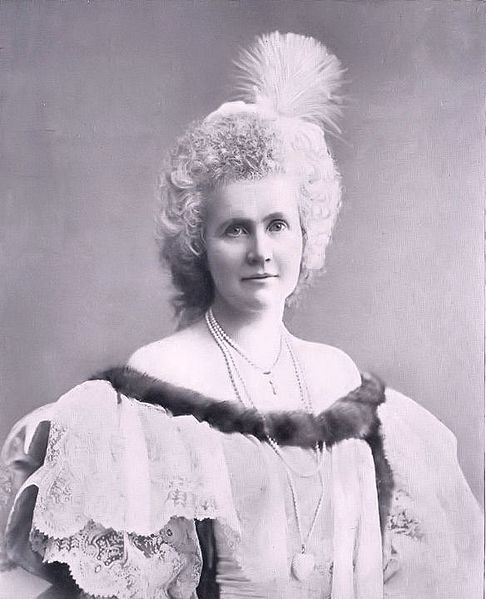 |
| Queen Elisabeth of Romania also known as Carmen Sylva. Image from Wikimedia Commons |
Probably no other 20th century royal could match the literary genius of Queen Elisabeth of Romania, best remembered, not only as Romania’s first queen consort, but as the acclaimed author Carmen Sylva. At the time of her death, she was a queen three times over: a royal queen, the queen of her people’s hearts, and queen of letters.
The Birth and Early
Life of Queen Elisabeth of Romania
She was born Princess Pauline Elisabeth Ottilie Luise of
Wied on December 29, 1843 at the Schloss Monrepos in Neuweid, Germany, the only
daughter and first child of Hermann, Prince of Wied, and his wife Princess
Marie of Nassau.
Elisabeth was homeschooled by tutors including linguist
Georg Sauerwein and pianist Clara Schumann, one of the most distinguished
pianists and composers of the Romantic era. Initially wanted to become a
teacher, though it was her passion for music and the arts that would prevail
later in life.
The Marital Prospects
of Queen Elisabeth of Romania
 |
| Queen Elisabeth of Romania wearing traditional Romanian costume. Image from Wikimedia Commons |
A 16-year-old Elisabeth was considered as a prospective bride for the future King Edward VII, whose mother, Queen Victoria, had a strong liking for the Princess of Wied that she asked her daughter Victoria to get to know the lady better. Victoria, however, had this to say about Elisabeth: "I do not think her at all distinguée looking—certainly the opposite to Bertie's usual taste." Furthermore, when Bertie was shown photographs of Elisabeth, he did not even bother to give them a second glance. In the end, the future king chose the tall and slender Alexandra of Denmark.
Elisabeth first met her future husband, Prince Karl of
Hohenzollern-Sigmaringen, in 1861 in Berlin. Eight years later, in 1869,
Elisabeth and now Prince Carol of Romania met again while the latter was
searching for a suitable consort. The two married November of the same year in
Nuewied, Germany. The union produced an only daughter, Maria, who was born in
September 1870. Unfortunately, the child would die scarlet fever in 1874, a
tragedy from which Elisabeth would never recover.
Elisabeth as Queen of
Romania
 |
| Queen Elisabeth of Romania (left) and King Carol I of Romania.Image from Wikimedia Commons |
Elisabeth was crowned Queen of Romania, and her husband, king, following the proclamation of Romania as a kingdom. She worked tirelessly to look after the wounded during the Russo-Turkish War, also known as the Romanian War of Independence. She later established Queen Elisabeth Blind Asylum in 1909 that catered to the visually impaired, as well as the Queen Elisabeth Society that provided free medical care for the underprivileged.
Queen Elisabeth of
Romania as Carmen Sylva
Queen Elisabeth heavily campaigned for the Romanian culture
and arts, promoting the beauty of her kingdom all throughout Europe. Elisabeth
and her ladies-in-waiting would wear traditional Romanian costumes at a time
when such were considered as “peasants’ garments”. Writing being her true passion, Elisabeth
wrote and published hundreds of poems, essays, short stories, novels, and plays
under the pseudonym Carmen Sylva. Her fluency in Romanian, English, French, and
German languages also helped her publish translations of other works. Elisabeth
received the Prix Botta prize from the Académie française in 1888 for her
volume of aphorisms entitled Les Pensees d'une reine.
Queen Elisabeth of
Romania and the Văcărescu Affair
 |
| Queen Elisabeth of Romania with her only child, Maria. |
King Carol I adopted his nephew Ferdinand in 1881 and considered him an heir due to the lack of one in the Romanian throne. The latter, however, started to get intimate with one of Elisabeth’s ladies-in-waiting, Elena Văcărescu, who Elisabeth believed was the reincarnation of her own daughter. The queen encouraged the budding romance despite being aware of the fact that the Romanian constitution prohibited a marriage between an heir and an ordinary citizen. In what is known as the Văcărescu Affair, Queen Elisabeth and Elena were exiled to Nuewied and Paris, respectively, while Ferdinand was sent to Europe in order to find a suitable bride for himself. Ferdinand eventually married the British princess, Marie of Edinburgh and Saxe-Coburg-Gotha. Ferdinand succeeded Carol in 1914 and Marie emerged as another popular queen consort.
Queen Elisabeth of Romania, the Eccentric and Romantic
The queen's eccentricity was well-known. She dabbled in spiritualism, levitation and faith-healing. She mourned the death of Marie all her life and her high-flown poetry were actually dedicated to her dead child. She would wander in flowing white robes and veils and played the violin to the fir trees near Sinaia. According to Prince Michael of Greece, Queen Elisabeth loved to shout her poems "from the terrace above the shore of the Black Sea towards the ships in front of her palace...a spectacle which left the marines rather dumbfounded."
Queen Elisabeth of Romania passed away on March 2, 1916 in Curtea de Argeş, Romania. She was 72 years old. She was buried beside her husband at the Cathedral of the Curtea de Argeş Monastery.
You may also want to read:
17 Facts About Queen Marie of Romania, Romania's Mamma Regina
The Wedding of Crown Prince Ferdinand of Romania and Princess Marie of Edinburgh, Later, King and Queen of Romania
10 Royals You didn’t Know were Actually Authors

.png)





0 Comments